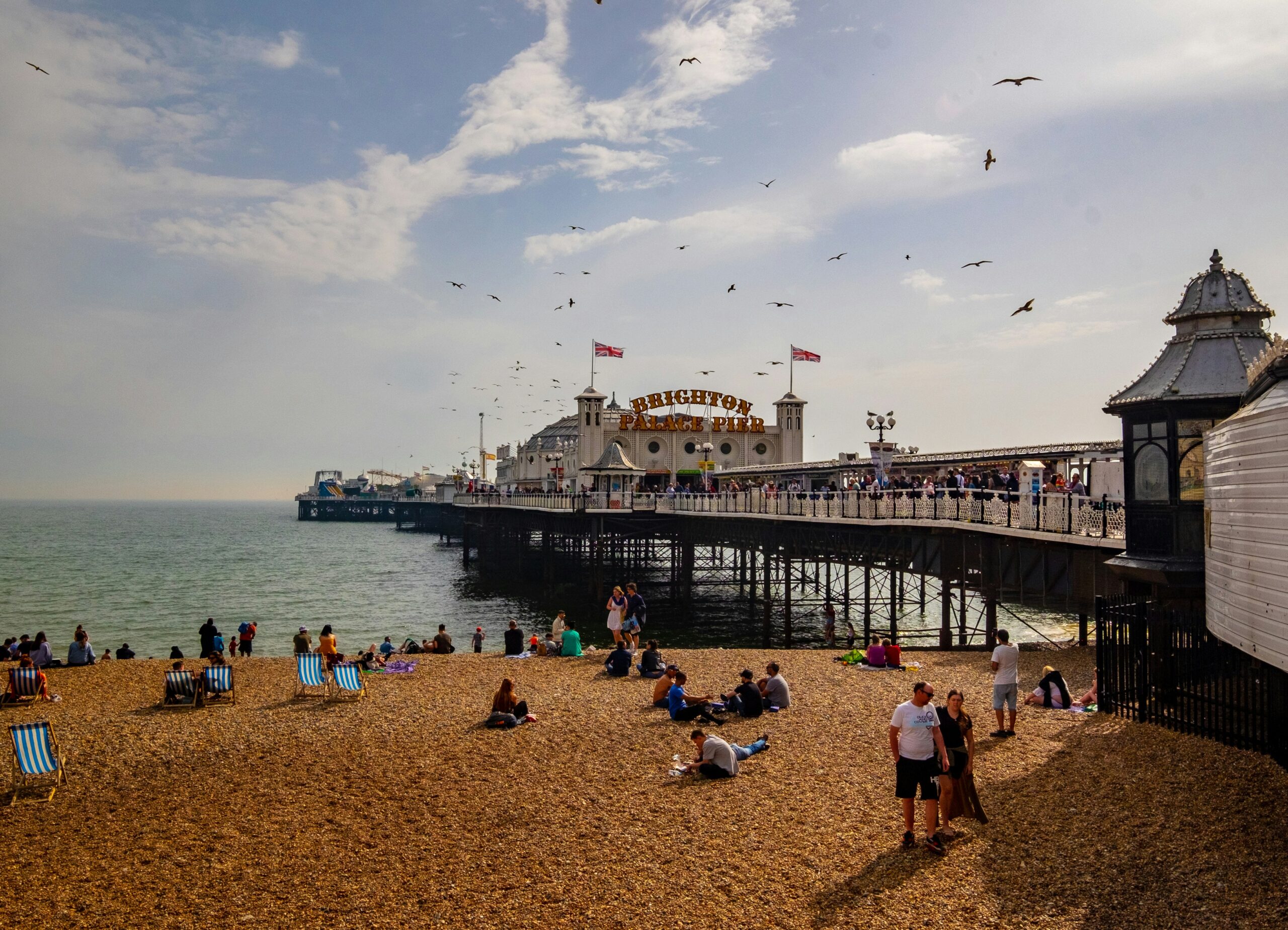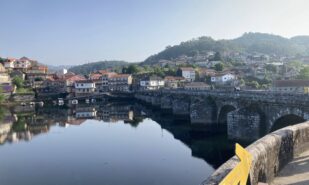Brighton… The very word whispers of a sea breeze, echoes with laughter from the pier, and resonates with the chords of a bold guitar melody. This town on England’s south coast is more than just a resort, more than just a place on the map. Brighton is a state of mind, a kaleidoscope of colours and characters, a perpetual celebration of life where everyone finds something of their own. It beckons with its eccentricity, captivates with its history, and inspires with its unyielding creative energy. On a Monday morning, it’s easier to meet someone in a carnival costume than in an office suit here.
Brighton, a Town of Freedom, Inspiration, and Sea Air
Located in the county of East Sussex, Brighton (officially part of the city of Brighton and Hove) stretches along a picturesque coastline, like a precious thread adorned by the white chalk cliffs of the Downs on one side and the boundless blue of the English Channel on the other. Its history spans centuries, its architecture astounds with its diversity, and its population is a vibrant tapestry of cultures and viewpoints. But above all, Brighton has always been and remains a magnet for creative individuals, for those who seek freedom of expression and who find inspiration in its unique atmosphere.
From Fishing Village to Royal Resort
Brighton’s history has roots stretching far back in time, when a small fishing village called Brighthelmston stood where the bustling town is today. This modest settlement lived a quiet, measured existence, entirely dependent on the whims of the sea and the labour of its few inhabitants. However, the 18th century brought about a transformation. A pivotal moment in Brighton’s destiny was the discovery of the purported health benefits of seawater and fresh air. Dr Richard Russell, a physician from Lewes, began to advocate sea bathing as a remedy for various ailments, and Brighthelmston gradually started to attract wealthy patients seeking healing and rejuvenation.

Brighton’s true ascent as a fashionable resort began with the visits of the Prince Regent, George IV. Eccentric and pleasure-loving, the Prince took a liking to Brighthelmston and in 1787 began the construction of his famous residence – the Royal Pavilion. This incredible palace in Indo-Saracenic style, with its domes, minarets, and exotic interiors, became a symbol of Brighton and drew aristocracy and high society to the town.
The arrival of the railway in 1841 made Brighton even more accessible to Londoners, and the town rapidly transformed into a popular leisure destination for all social classes. Elegant terraces were built, parks were laid out, and hotels and entertainment venues opened. Brighton became synonymous with seaside holidays, entertainment, and freedom.
An Architectural Symphony: From Georgian Elegance to Modern Eclecticism
Brighton’s architecture is a captivating journey through time, reflecting various eras and styles. Strolling through the town’s streets, you can see graceful Georgian terraces with their clean lines and balconies, majestic Victorian mansions adorned with stucco and bay windows, and bold modern buildings harmoniously integrated into the historical landscape.
The heart of Brighton’s architectural ensemble is undoubtedly the Royal Pavilion. This fantastical structure, created by John Nash, captivates the imagination with its unusual blend of Eastern motifs and European elegance. Its vibrant colours, onion-shaped domes, and exquisite interiors make it a truly unique architectural landmark.

Another of Brighton’s defining features is its terraces. Elegant rows of houses facing the sea or situated along leafy squares are fine examples of Georgian and Victorian town planning. Among the most famous are Regency Square, Brunswick Terrace, and Adelaide Crescent, striking in their symmetry and grandeur.
The iconic Brighton Palace Pier cannot be overlooked. Built in 1899, it remains a significant attraction and a vibrant symbol of entertainment and leisure. Its Victorian architecture, amusements, cafes, and shops create an unmistakable festive atmosphere.
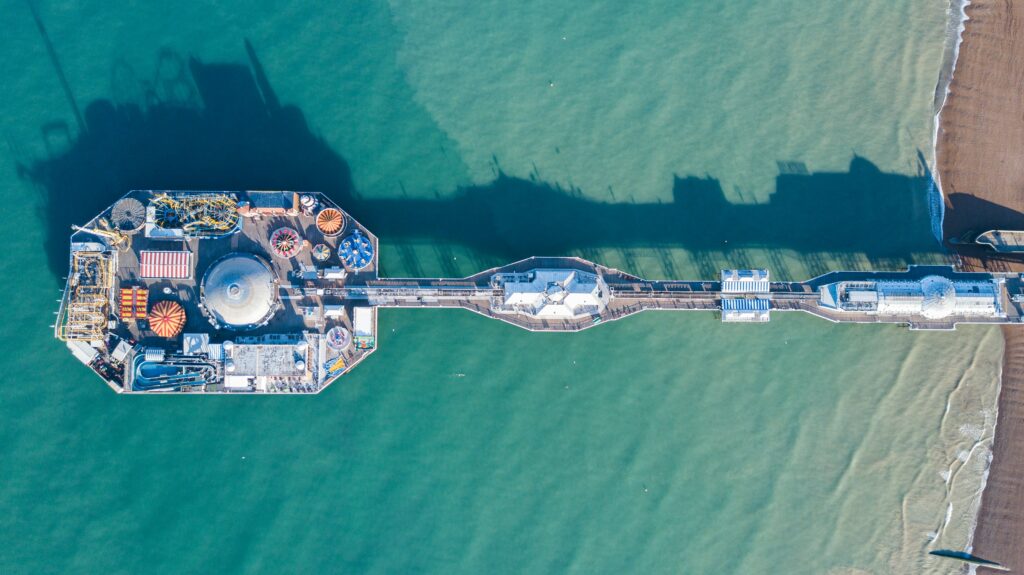
Brighton’s modern architecture also deserves attention. Here, you can find bold and innovative projects that blend harmoniously with the historical buildings, giving the town a dynamic and contemporary feel.
A Kaleidoscope of Cultures and Viewpoints
Brighton’s population is one of its most vibrant and appealing characteristics. The town has always been known for its tolerance, openness, and diversity. Here, representatives of various cultures, nationalities, sexual orientations, and viewpoints coexist peacefully. This atmosphere of freedom and acceptance attracts creative professionals, students, retirees, and anyone who values individuality and independence.
Brighton is often referred to as the “gay capital of the UK” due to its large and active LGBTQ+ community. The annual Brighton Pride is one of the largest and most colourful in the country.
Students make up a significant portion of Brighton’s population, thanks to the presence of two major universities – the University of Brighton and the University of Sussex. The young and energetic student environment brings dynamism and fresh ideas to the town.
Overall, Brighton’s population is characterised by its progressive, creative, and cheerful spirit. It’s a town where everyone can be themselves and feel accepted.
A Creative Mecca: Writers, Musicians, Artists…
Brighton has always been a source of inspiration for artists. Its picturesque landscapes, sea air, atmosphere of freedom, and eccentricity have attracted and continue to attract writers, musicians, artists, and other creative individuals. Many of them were born, grew up, lived, or worked in this remarkable town, leaving their mark on its cultural heritage.
Although Jane Austen never lived in Brighton, the town played a significant role in her novel Pride and Prejudice. It is to Brighton that the flighty Lydia Bennet elopes with the officers, leading to serious consequences. The description of Brighton as a fashionable resort of the time in the novel is quite vivid.
The great English writer Virginia Woolf spent much time in Brighton during her childhood and youth. Her memories of the sea and the coast are reflected in her works, such as To the Lighthouse. The atmosphere of Brighton, with its crashing waves and cries of seagulls, undoubtedly influenced her sensual and poetic style.
The renowned writer Graham Greene lived in Brighton for a time, and his famous novel Brighton Rock is set in the town. The dark and tense atmosphere of post-war Brighton, with its gangs and crime, is masterfully recreated on the pages of the book.
One of the most prominent contemporary British writers, Ian McEwan, was born in Oxford but has spent a significant part of his life in Brighton. The town’s atmosphere, its contrasts, and its characters often permeate his works.
The prolific writer and critic Angus Wilson lived in Brighton for many years and drew inspiration from its history and people. His novels often explore the social and psychological aspects of middle-class life in post-war England, and Brighton served as a perfect backdrop for this.
The popular contemporary writer Kate Atkinson lives in Brighton. Her novels, which combine elements of detective fiction, historical prose, and psychological drama, often feature subtle humour and a deep understanding of human nature.
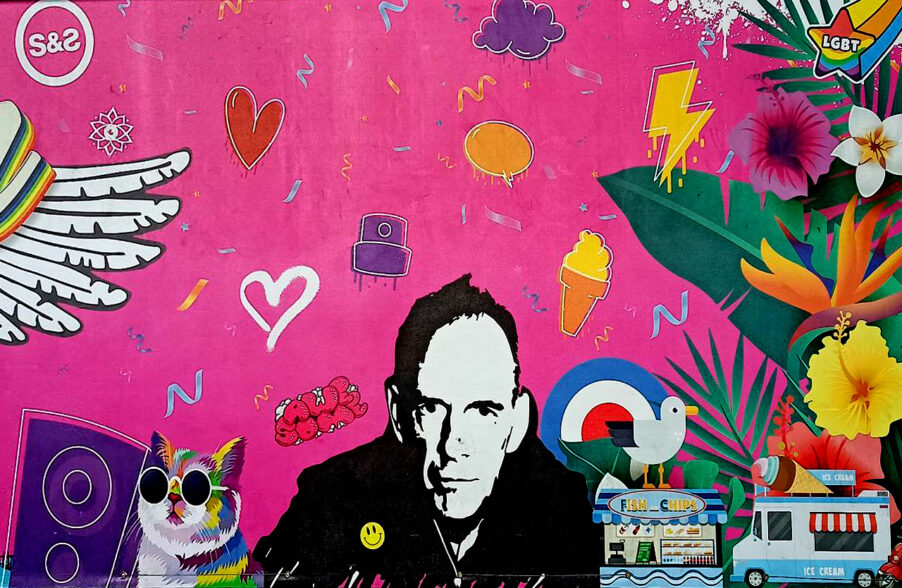
Brighton has always been a hub of musical life, giving rise to talented performers and attracting famous musicians from all over the world. One of Brighton’s most famous residents, the legendary DJ and producer Norman Cook, better known as Fatboy Slim, made Brighton the capital of big beat. The godfather of Brighton’s electronic music scene, his legendary Big Beach Boutique shows attracted up to 250,000 spectators to the beach. He still lives and works in Brighton, remaining an important figure in its musical life. He owns the Big Beach Café, where he hosts free discos for families with children every Sunday.
Although Nick Cave was born in Australia, he lived in Brighton for a long time and undoubtedly found inspiration in its dark and poetic atmosphere. His music and lyrics often explore themes of love, death, and spirituality.
The popular indie-rock band The Kooks formed in Brighton in 2004. Their melodic songs and energetic performances quickly gained fans worldwide.
Royal Blood: This influential rock band, consisting of just two members, also hails from Brighton. Their powerful sound and uncompromising style have made them one of the most prominent British rock bands of the last decade.
Many other musicians, both famous and emerging, find a favourable environment for creativity in Brighton. There are numerous concert venues, music clubs, and recording studios here.
Brighton has always attracted artists with its picturesque nature, unusual architecture, and free atmosphere. John Constable often came here to paint seascapes. His paintings depicting the turbulent sea and dramatic skies of Brighton are an important part of British art.
J.M.W. Turner – another great British landscape painter, Turner was also captivated by the sea views of Brighton. His expressive and emotional paintings convey the full power and beauty of the marine element. Brighton has numerous art galleries, studios, and workshops where contemporary artists, sculptors, and photographers work. The Brighton Festival, held annually, attracts creative people from all over the world.
Where to go and what not to miss?
Brighton offers its guests and residents many interesting places and activities. The Royal Pavilion is undoubtedly the town’s main attraction. This exotic palace impresses with its architecture and opulent interiors. Brighton Palace Pier is a classic British seaside pier with amusements, arcade games, cafes, and restaurants. It offers stunning views of the town and the sea. British Airways i360: A modern observation tower 162 metres high, lifting visitors to a 360-degree view of Brighton and the surrounding area.
The Lanes are a network of narrow, winding alleyways in the historical centre of the town, filled with boutiques, antique shops, jewellers, cafes, and pubs. It’s the perfect place for strolling and finding unique souvenirs. And then there’s the North Laine – an even more bohemian area with independent shops, vintage stores, art galleries, and vegetarian cafes. An atmosphere of alternative culture prevails here.

Brighton Museum & Art Gallery offers a diverse collection of art, history, and archaeology.
Theatre Royal Brighton is a historic theatre hosting plays, concerts, and other cultural events.
Brighton is also home to one of the oldest aquariums in the world, Sea Life Brighton, offering a fascinating journey into the underwater world.
Но, пожалуй, главная достопримечательность Брайтона — протяжённый галечный пляж с множеством кафе, баров и развлечений, летом здесь царит самая оживленная атмосфера. А живописные холмы и долины национального парка Саут-Даунс (South Downs National Park), расположенного к северу от города, идеально подходят для пеших и велосипедных прогулок.
Brighton’s most outstanding landmark though must be its long pebble beach with numerous cafes, bars, and entertainment options. In summer, it has a lively atmosphere. The picturesque hills and valleys located north of Brighton, ideal for hiking and cycling, form the South Downs National Park. And many other interesting, mysterious, historical, or artistic places.
Brighton Today: A Town That Never Sleeps
Today, Brighton remains one of the most vibrant and dynamic towns in the UK. It successfully combines the charm of a historical resort with the spirit of a modern and progressive centre. Its creative energy continues to flow, attracting new artists, musicians, and writers.
Brighton is a town where elegant Georgian terraces stand alongside bold graffiti, bustling pubs neighbour quiet squares, and classic pier amusements coexist with contemporary art installations. This eclecticism makes it unique and appealing to a wide variety of people.
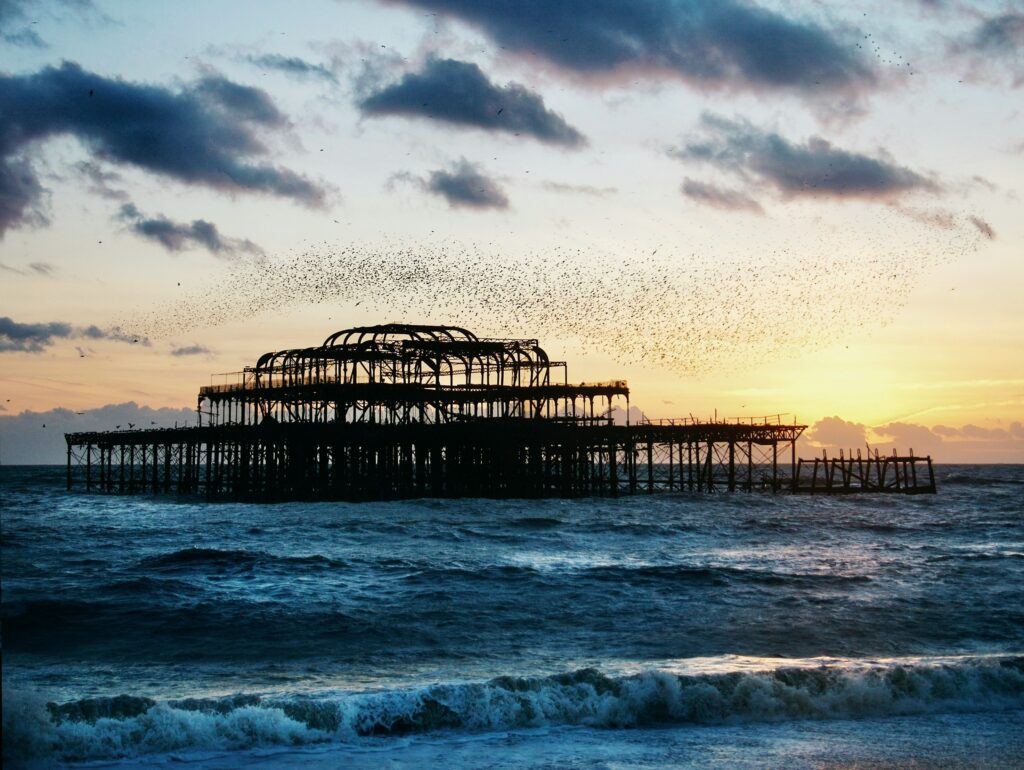
This town, like a pocket of Time, has preserved the spirit and rhythm of England and London at the beginning of the 21st century.
Brighton continues to develop and change, but its spirit of freedom, creativity, and love of life remains constant.
It’s a town you fall in love with at first sight and one that leaves a lasting impression on your heart. Come to Brighton, breathe in its sea air, feel its rhythm, and perhaps it is here that you will find your own inspiration.

